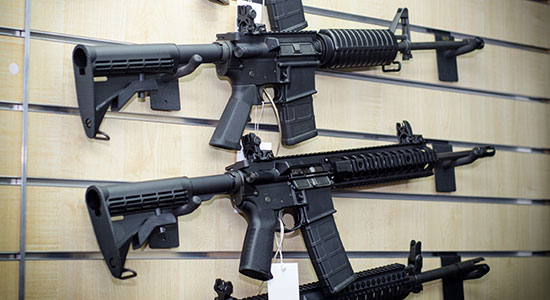
Sept. 18, 2019 – The U.S. Supreme Court may decide whether a state’s consumer protection laws are ammunition for wrongful death claims against a gun maker who marketed a particular model of assault-style rifle used in a mass school shooting.
It was Dec. 14, 2012, when a disturbed Adam Lanza entered Sandy Hook Elementary School in Newtown, Connecticut, and used a Bushmaster AR-15, Model XM15-E2S semiautomatic assault-style rifle to kill 20 first graders and six staff members.
At the time, Connecticut law did not ban possession or sale of assault-style firearms (it does now). Since the Sandy Hook shooting, almost 2,500 people have been killed in other U.S. mass shootings1 including mass shootings in Ohio and Texas last month.
But the pending case, Remington Arms Co. v. Soto, isn’t about the right to possess or sell assault weapons. It’s about whether victims of mass shootings (or their estates), can look to state consumer protection laws – specifically unfair trade practice laws on marketing and advertising – to hold gun manufacturers liable if a mass shooting occurs.
Earlier this year, the Connecticut Supreme Court ruled (4-3) that a gun manufacturer could be liable if victims can prove unlawful marketing proximately caused the harm. Last month, the gun manufacturer filed a petition for review at the U.S. Supreme Court.
Predicate Exception
A federal law, known as the Protection of Lawful Commerce in Arms Act of 20052 (PLCAA), prohibits lawsuits against gun manufacturers, dealers and distributors based on “harm caused by the misuse of firearms by third parties, including criminals.”
 Joe Forward, Saint Louis Univ. School of Law 2010, is a legal writer for the State Bar of Wisconsin, Madison. He can be reached by email or by phone at (608) 250-6161.
Joe Forward, Saint Louis Univ. School of Law 2010, is a legal writer for the State Bar of Wisconsin, Madison. He can be reached by email or by phone at (608) 250-6161.
There are exceptions.3
One exception allows “actions in which a manufacturer or seller of a qualified product violated a state or federal statute applicable to the sale or marketing of the product, and the violation was a proximate cause of the harm for which relief is sought.”4
This exception is known as a “predicate exception” because “the plaintiff must allege a knowing violation of a predicate statute”5 – in this case, a state or federal law that restricts the marketing practices of firearm manufacturers or dealers.
The plaintiffs – estates of nine killed at Sandy Hook Elementary School – alleged that the gun maker, Bushmaster Firearms International LLC (now a brand owned by Remington Arms Company LLC), violated the Connecticut Unfair Trade Practices Act (CUTPA) through unlawful marketing and the violation proximately caused the harm.
In March, the Connecticut Supreme Court (4-3) ruled that the plaintiffs “are entitled to have the opportunity to prove their wrongful marketing allegations” – that the gun maker “violated CUTPA by marketing the XM15-E2S to civilians for criminal purposes, and that those wrongful marketing tactics caused or contributed to the Sandy Hook massacre.”
A Connecticut trial court had granted the gun manufacture’s motion to strike that specific claim, as well as other claims. Last month, Remington Arms Company appealed to the U.S. Supreme Court, which has not decided whether to take the case.
The National Rifle Association (NRA), 10 states, and 22 members of the U.S. House of Representatives (including Wisconsin Reps. James Sensenbrenner Jr. and Glenn Grothman) have filed amicus briefs supporting the position asserted by Remington Arms Company. The Soto plaintiffs have until Oct. 4, 2019, to respond.
Marketing at Issue
Again, the PLCAA’s predicate exception says the federal law does not bar lawsuits if a gun manufacturer “violated a state or federal statute applicable to the sale or marketing of the product, and the violation was a proximate cause of the harm.”
In the Sandy Hook shooting, the assailant used an AR-15 style assault rifle, which is a semi-automatic version of the U.S. Army’s standard issue M16 service rifle.
“The AR-15 and M16 are highly lethal weapons that are engineered to deliver maximum carnage with extreme efficiency,” wrote one justice on the Connecticut Supreme Court, noting it’s “the weapon of choice for mass shootings, including school shootings.”
Bushmasters manufactured the gun. It was ultimately sold to a retailer, Riverview Sales Inc. (also a defendant at one time), which sold the gun to Adam Lanza’s mother.
Lanza’s mother bought it for her 17-year-old son, Adam, who had expressed an interest in joining the U.S. Army Rangers. Less than a year later, he used the weapon at Sandy Hook Elementary School. It took him less than 5 minutes to kill 26 people.
The plaintiffs argue Remington violated CUTPA with unethical marketing that promoted its AR-15s to civilians as combat weapons, depicting soldiers on patrol armed with AR-15s and using phrases such as, “the uncompromising choice when you demand a rifle as mission adaptable as you are” and “the ultimate combat weapons system.”
In essence, the plaintiffs argued the marketing promoted the assault-rifle as a killing weapon of combat, not for civilian purposes like hunting or sport shooting.
The plaintiffs also argued that this marketing was a substantial factor in causing the Sandy Hook deaths because Lanza was susceptible to militaristic marketing.
The complaint alleged Lanza dreamed of becoming an Army Ranger and specifically chose the XM15-E2S among lesser weapons in his arsenal, suggesting the XM15-E2’s tie to military themes was a substantial factor in his decision to use it at Sandy Hook.
In addition, the plaintiffs noted that Lanza was a video gamer devoted to first-person firearm games that depicted variants of the XM15-E2S, and he used some of the techniques learned from the video games in his attack on the school.
Lanza was encouraged to select the XM15-E2S because of the military-themed marketing, the plaintiffs argued; a lesser weapon would have caused fewer casualties.
The Connecticut Supreme Court ruled that plaintiffs alleged a cognizable CUTPA violation and CUTPA constitutes a predicate statute under PLCAA.
The trial court had granted a motion to strike on the grounds that the plaintiffs lacked standing – they had no consumer or commercial relationship to the gun maker.
But the state supreme court said the plaintiffs had standing because the applicable consumer protection statute stays “any person” harmed by a violation can sue. In other words, the statute does not require a business transaction between the parties.
“If the defendants’ marketing materials did in fact inspire or intensify the massacre, then there are no more direct victims than these plaintiffs; nor is there any customer of the defendants’ with a better claim to standing,” the majority opinion states.
The three-justice dissent, calling the case a “national question of first impression,” said the “predicate exception encompasses only those statutes that govern the sale and marketing of firearms and ammunition specifically, as opposed to generalized unfair trade practice statutes” that govern a broad array of commercial activity.
Petition for Writ of Certiorari
Remington Arms Company is asking the U.S. Supreme Court to take the case and reverse the Connecticut Supreme Court’s 4-3 decision. Its cert petition says the PLCAA preempts the claim and the state court’s majority decision sweeps much too broadly.
Like the dissent, Remington argues that predicate exceptions to the PLCAA only include statutes that specifically regulate firearms or the firearms industry, not general statutes that are “merely capable of being applied” to firearms sales or marketing.
“The PLCAA’s operative text, Congress’s findings and purposes, and the PLCAA’s legislative history all point to one conclusion: General unfair trade practices laws like CUTPA are not encompassed by the predicate exception,” the petition states.
The petition notes that “all states have analogous unfair trade practices laws,” and the Connecticut decision “threatens to unleash a flood of lawsuits nationwide that would subject lawful business practices to crippling litigation burdens.”
Filed last month, the petition for review also asserts that the Connecticut decision conflicts with federal appellate decisions, City of New York v. Beretta U.S.A. Corp.6 and Ileto v. Glock Inc.7
However, in both those cases, the courts ruled that the PLCAA preempted state tort claims against gun manufacturers based on theories of public nuisance and negligence, not based on consumer protection laws that regulate marketing and trade practices.
Stanford Law Professors Nora Engstrom and David Studdert, discussing the case, noted that U.S. Supreme Court will likely decide to review the case. But even if the lawsuit is allowed to proceed, it would go back to the trial court for more litigation.
Conclusion
After Sandy Hook, both Connecticut and New York (and other states) banned certain assault-style weapons within their borders, such as the AR-15, and the U.S. Supreme Court refused to hear challenges to those bans, leaving them in place.
Wisconsin and other states do not have assault weapons bans. Thus, any decision in Remington Arms v. Soto would have the largest impact on states without such bans, since marketing of assault-style weapons would be targeting people in those states.
Endnotes
1 See Vox, https://www.vox.com/a/mass-shootings-america-sandy-hook-gun-violence. This database defines mass shooting as “events in which four or more people, excluding the shooter, were shot but not necessarily killed at the same general time and location.”
2 15 U.S.C. § 7901.
3 See 15 U.S.C. § 7903(5).
4 15 U.S.C. § 7903(5)(A)(iii).
5 Soto v. Bushmaster Firearms Int'l, LLC, 331 Conn. 53, 68, 202 A.3d 262, 274 (2019).
6 524 F.3d 384 (2nd Cir. 2008).
7 565 F.3d 1126 (9th Cir. 2016).
